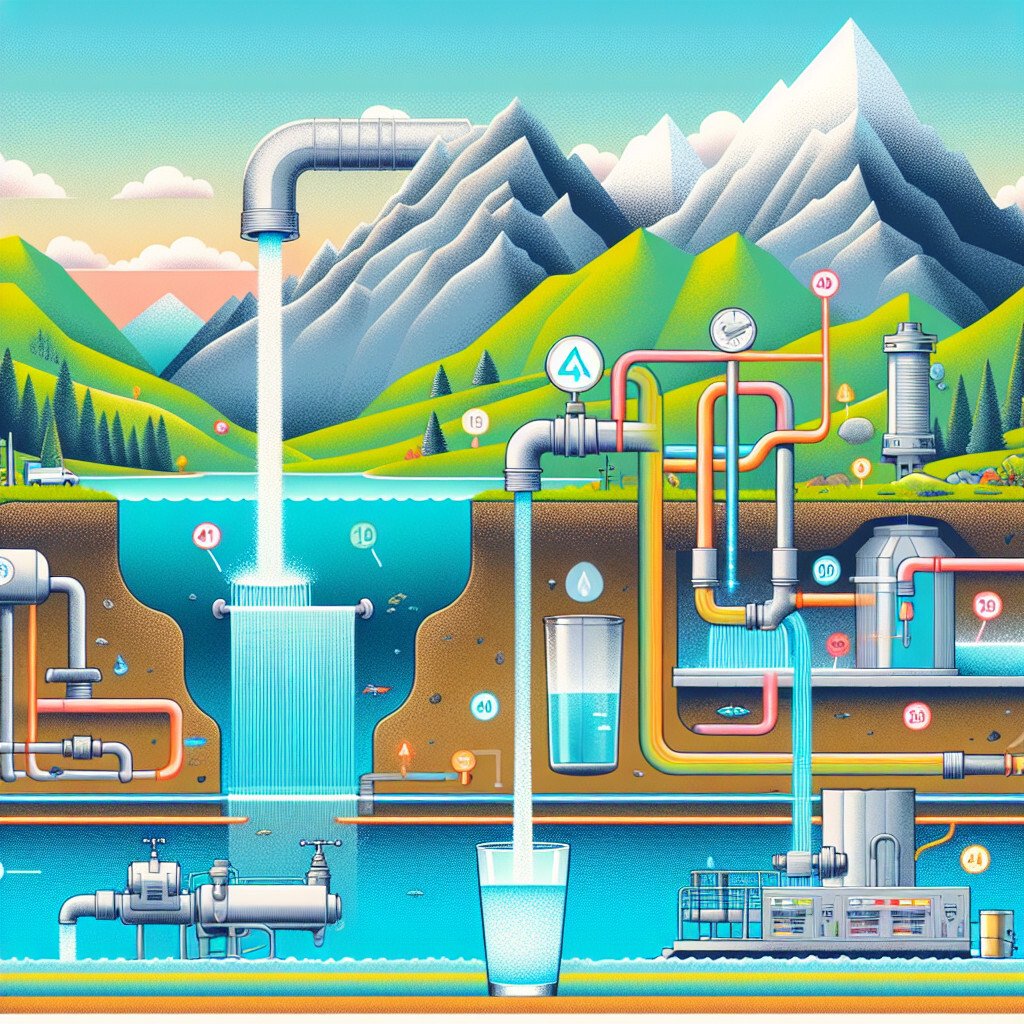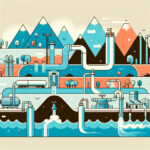-
Table of Contents
“Tap Water: Journey from Nature’s Heart to Your Home!”
Introduction

Tap water originates from various sources such as rivers, lakes, reservoirs, and underground aquifers. It is collected and then treated at water treatment facilities to remove harmful substances and ensure it is safe for consumption. After treatment, the water is distributed to homes and businesses through a complex network of pipes. The quality and taste of tap water can vary depending on the source and the treatment process.
Understanding the Journey of Tap Water: From Source to Sink
Understanding the journey of tap water from its source to your sink is a fascinating exploration of the complex systems that ensure the delivery of clean, safe water to homes and businesses. This process involves multiple stages, each of which plays a crucial role in maintaining the quality and safety of the water we use daily.
The journey of tap water begins at the source, which can be either surface water or groundwater. Surface water includes rivers, lakes, and reservoirs, while groundwater is found beneath the earth’s surface in aquifers, which are porous rocks that can hold and transmit water. The choice of source depends on geographical location and availability. For instance, a city located near a large river may primarily use surface water, while a rural area might rely on groundwater.
Once the water is sourced, it is transported to a treatment plant. This is where the water undergoes a series of treatments to remove impurities and make it safe for consumption. The first step in this process is coagulation and flocculation, where chemicals are added to the water to bind with dirt and other particles, forming larger particles called flocs. These flocs are then removed during the sedimentation process, where they settle at the bottom due to their weight.
Following sedimentation, the water goes through filtration, where it passes through layers of sand, gravel, and charcoal to remove even smaller particles. The final step in the treatment process is disinfection, where chemicals such as chlorine or ultraviolet light are used to kill any remaining bacteria or viruses.
After the water has been treated, it is stored in a clean, safe environment until it is needed. This could be a water tower or a reservoir. The storage step is crucial as it allows time for the disinfection process to complete and ensures that there is always a sufficient supply of water available for distribution.
The final stage in the journey of tap water is distribution. The treated and stored water is pumped through a network of pipes to homes, businesses, and other establishments. This network of pipes is vast and complex, often running underground to avoid disruption to the surface environment. The water pressure is carefully controlled to ensure that the water reaches all areas of the network, even those at higher elevations.
Throughout this journey, the water is regularly tested to ensure it meets the required safety standards. These tests check for a variety of factors, including pH levels, turbidity (cloudiness), and the presence of harmful bacteria or chemicals. If any issues are detected, the water can be treated again or the source can be changed to ensure the continued delivery of safe, clean water.
In conclusion, the journey of tap water from source to sink is a complex process involving sourcing, treatment, storage, and distribution. Each stage is carefully managed and monitored to ensure the delivery of safe, clean water to homes and businesses. By understanding this journey, we can better appreciate the vital role that water infrastructure plays in our daily lives and the importance of maintaining and investing in these systems for future generations.
The Role of Water Treatment Plants in Providing Tap Water
Water is an essential element of life, and its availability in a clean, safe form is a fundamental human necessity. In many parts of the world, this need is met through the provision of tap water, a service that is often taken for granted. However, the journey of water from its natural source to our taps is a complex process that involves a series of intricate steps, primarily carried out in water treatment plants.
Water treatment plants play a pivotal role in ensuring the provision of safe and clean tap water. They are designed to remove impurities and make water safe for human consumption. The process begins with the collection of raw water from various sources such as rivers, lakes, and underground wells. This raw water is then transported to the treatment plants through a network of pipes and pumping stations.
Upon arrival at the treatment plant, the water undergoes a series of treatment processes. The first step is usually coagulation and flocculation, where chemicals are added to the water to bind together the small particles of dirt and other impurities into larger particles called ‘flocs.’ Following this, the water is directed into sedimentation basins where the heavy flocs settle at the bottom and are removed.
Subsequently, the water is filtered through layers of fine sand and gravel to remove any remaining particles. This filtration process is crucial as it helps to eliminate bacteria, viruses, and chemicals that may be harmful to human health.
After filtration, the water is disinfected, typically using chlorine or ultraviolet light. This step is vital in killing any remaining bacteria or viruses, ensuring that the water is safe for consumption. In some cases, additional treatments may be applied to address specific water quality issues, such as the removal of certain chemicals or the adjustment of the water’s pH level.
Once the water has been thoroughly treated, it is stored in clean, safe reservoirs before being distributed to homes and businesses through a vast network of pipes. This distribution system is continuously monitored and maintained to ensure that the water remains clean and safe as it travels from the treatment plant to the tap.
It is important to note that the process of treating and delivering tap water is heavily regulated by health and environmental agencies. These agencies set stringent standards for water quality and regularly test the water at various stages of the treatment process to ensure these standards are met.
In conclusion, the role of water treatment plants in providing tap water is indispensable. They ensure that the water we consume is free from harmful impurities and safe for consumption. The journey of water from its natural source to our taps is a testament to human ingenuity and the importance we place on health and hygiene. So, the next time you turn on your tap, take a moment to appreciate the complex process that makes this everyday convenience possible.
Exploring the Natural Sources of Our Everyday Tap Water
Water is an essential part of our daily lives. We use it for drinking, cooking, cleaning, and a myriad of other tasks. But have you ever stopped to wonder where the water that flows from your tap originates? The journey of water from its natural source to our homes is a fascinating process that involves a complex system of filtration and treatment.
The primary sources of tap water are surface water and groundwater. Surface water includes rivers, lakes, and reservoirs, while groundwater is found beneath the earth’s surface in aquifers, which are porous rocks that can hold and transmit water. The choice between these two sources largely depends on geographical location and availability.
In areas where surface water is abundant, such as near rivers or lakes, it is often the primary source of tap water. The water is collected in reservoirs or drawn directly from the source. However, surface water is susceptible to contamination from human activities and natural processes, including industrial discharge, agricultural runoff, and microbial pathogens. Therefore, it requires extensive treatment before it is safe for consumption.
On the other hand, groundwater is often cleaner than surface water because the soil acts as a natural filter, trapping particles and pathogens. However, groundwater can still be contaminated by human activities, such as the improper disposal of hazardous materials or the overuse of fertilizers and pesticides. In such cases, the water must be treated to remove the contaminants.
Once the water is collected from its source, it undergoes a series of treatment processes to ensure it is safe for consumption. The first step is coagulation and flocculation, where chemicals are added to the water to bind with dirt and other particles, forming larger particles called flocs. These flocs are then removed during the sedimentation process.
Following sedimentation, the water is filtered to remove any remaining particles and microorganisms. The type of filtration used depends on the quality of the source water. For instance, surface water often requires more extensive filtration than groundwater.
After filtration, the water is disinfected to kill any remaining bacteria, viruses, and other pathogens. This is typically done using chlorine or chloramine. However, some water treatment facilities use ultraviolet light or ozone for disinfection.
Once the water has been treated, it is stored in clean, covered reservoirs until it is needed. From there, it is distributed through a network of pipes to homes and businesses. Along the way, the water is regularly tested to ensure it meets health and safety standards.
In conclusion, the journey of water from its natural source to our taps is a complex process that involves careful collection, extensive treatment, and regular testing. Whether it comes from a river, a lake, or an underground aquifer, the water we use every day has undergone a rigorous process to ensure it is safe for consumption. So, the next time you turn on your tap, take a moment to appreciate the journey that water has taken to reach you.
The Process of Converting Groundwater into Tap Water
Water is a fundamental necessity for life, and tap water is one of the most common sources of this vital resource. The journey of water from the ground to our taps is a fascinating process that involves a series of complex steps. This article will delve into the process of converting groundwater into tap water, providing a comprehensive understanding of where our tap water comes from.
Groundwater is the primary source of tap water. It is found beneath the earth’s surface, stored in porous rocks known as aquifers. These aquifers, acting as natural reservoirs, are replenished by rain and snow that seep into the ground. The process of converting this groundwater into tap water begins with extraction. Wells are drilled deep into these aquifers, and water is pumped up to the surface.
Once the water is brought to the surface, it undergoes a rigorous purification process to ensure it is safe for consumption. The first step in this process is screening, where large debris like leaves, twigs, and other particulates are removed. This is followed by aeration, a process that exposes the water to air to eliminate gases and volatile compounds.
The next step is coagulation and flocculation, where chemicals are added to the water to bind with dirt and other particles, forming larger particles called floc. The floc is then removed during the sedimentation process, where it settles at the bottom of the water supply due to its weight.
Following sedimentation, the water undergoes filtration to remove any remaining particles. This is typically achieved using sand, gravel, and charcoal filters that trap and remove microscopic contaminants. After filtration, the water is disinfected to kill any remaining bacteria, viruses, and other harmful microorganisms. This is usually done by adding chlorine or using ultraviolet light.
Once the water has been thoroughly cleaned, it is stored in clean, covered reservoirs. From these reservoirs, the water is distributed to homes and businesses through a network of pipes. Before it reaches our taps, the water is often treated again to adjust its pH and remove any remaining impurities. This final treatment ensures that the water is not only safe to drink but also has a pleasant taste.
It’s important to note that the process of converting groundwater into tap water can vary depending on the quality of the groundwater and the specific requirements of a community. Some areas may require additional treatment steps, such as softening to remove excess minerals, or fluoridation to promote dental health.
In conclusion, the journey of water from the ground to our taps is a complex process that ensures the water we consume is safe and clean. It involves extraction, multiple stages of purification, storage, and distribution. This process is a testament to the advancements in water treatment technology and the commitment to public health. So, the next time you turn on your tap, you’ll have a better understanding of where that water comes from and the journey it has taken to reach you.
Q&A
1. Question: Where does tap water come from?
Answer: Tap water typically comes from two main sources: surface water, such as lakes, rivers, and reservoirs, or groundwater from underground aquifers.
2. Question: How is tap water treated before it reaches our homes?
Answer: Tap water is treated at a water treatment plant where it undergoes several processes including filtration, coagulation, sedimentation, and disinfection to remove harmful contaminants and make it safe for consumption.
3. Question: Can tap water come from rainwater?
Answer: Yes, in some areas, rainwater is collected, treated, and used as a source of tap water. However, this is not common practice in most places due to the need for extensive treatment and filtration.
4. Question: Is tap water always sourced locally?
Answer: Not always. While many communities source their water from local reservoirs, rivers, or wells, some areas may not have sufficient local water resources and need to import water from elsewhere.
Conclusion
Tap water comes from either surface water sources like rivers, lakes, and reservoirs, or from underground sources like aquifers. It is then treated in water treatment facilities to remove impurities and ensure it is safe for consumption before being distributed to homes and businesses through a network of pipes.






